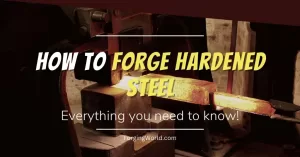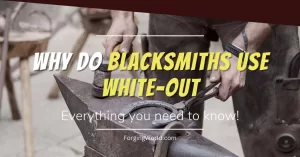Propane and coal are the best fuels for blacksmithing and making knives. However, many beginners might not be ready to invest in a gas forge or don’t want to deal with the hassle and mess of coal. Fortunately, there’s a quick and easy workaround for both of these problems: MAPP gas.
Many of us already have a MAPP gas torch handy in our garages or workshops, but can you forge with it?
In this article, I want to go over my step-by-step guide on how to forge with a MAPP gas torch. I’ll also cover its Pros and Cons as well as provide some tips to help you get started.
Can You Forge With MAPP Gas?
Yes, you can forge with MAPP gas! MAPP gas is a mixture of methylacetylene and propadiene, and it burns at a hotter temperature than propane, making it a suitable fuel for forging.
However, forging with MAPP does have some limitations, including being more expensive and burning faster than propane. It’s essential to consider these factors before deciding to use MAPP gas for your forging projects.
Pros and Cons of MAPP Gas Forging
Here are some of the pros and cons of forging with MAPP gas:
Pros:
MAPP gas burns at a hotter temperature than propane, which can be advantageous for certain projects.
It’s easy to light and doesn’t require any special equipment or setup.
MAPP gas is more readily available than coal, and you don’t have to deal with the mess of coal.
Cons:
MAPP gas is more expensive than propane and can be harder to find in some areas.
It burns faster than propane, so you’ll go through fuel more quickly.
It can be challenging to control the temperature, which may make it more difficult to work with than propane or coal.
Step-by-Step Guide to Forging With MAPP Gas
Now that you know the pros and cons of forging with MAPP gas, let’s get into the step-by-step guide:
Step 1: Gather Your Equipment
To forge with MAPP gas, you’ll need a few essential tools, including:
- A MAPP gas torch
- A propane regulator and hose
- A forge (you can make one out of firebricks or purchase one)
- A pair of tongs
- Safety gear (gloves, eye protection, and closed-toe shoes)
Step 2: Set Up Your Workspace
Before you start forging, make sure you have a well-ventilated area with a fireproof surface, such as concrete or brick. It’s also a good idea to have a fire extinguisher on hand in case of an emergency. Set up your forge and make sure it’s secure and stable.
Step 3: Connect Your Equipment
Connect the propane regulator and hose to the MAPP gas torch and tank. Make sure everything is secure and tightly connected.
Step 4: Light Your Torch
Turn on the gas and light your torch. Adjust the flame to a low setting and gradually increase the heat as needed.
Step 5: Heat Your Metal
Use your tongs to hold your metal piece and move it around in the flame to heat it evenly. Be careful not to overheat the metal, as this can cause it to become brittle or crack.
Step 6: Shape Your Metal
Once your metal is heated to the desired temperature, use your hammer and anvil to shape it into your desired form. Repeat the heating and shaping process as needed.
Step 7: Quench Your Metal
Once your metal is shaped, quench it in a container of water or oil to cool it down quickly and prevent it from losing its shape.
Safety Considerations When Forging with MAPP
It’s essential to follow safety protocols when forging with MAPP gas. Make sure you have the proper protective gear, and never leave your forge unattended while it is lit.
Always keep a fire extinguisher nearby in case of an emergency, and make sure there are no flammable items or liquids within reach of your forge. Lastly, never breathe in the fumes from your forge or torch, as they can be toxic.
Frequently Asked Questions
Is MAPP gas safe to use for forging?
Yes, MAPP gas is generally considered safe for forging, as long as you take proper safety precautions and work in a well-ventilated area.
Can I use MAPP gas with any type of metal?
Yes, you can use MAPP gas to forge with a variety of metals, including steel, iron, and copper.
How hot does MAPP gas burn?
MAPP gas burns at a temperature of approximately 3,730 degrees Fahrenheit (2,054 degrees Celsius).
Is MAPP gas more expensive than propane?
Yes, MAPP gas is generally more expensive than propane, but it burns hotter and faster than propane, so you may need less of it to complete your projects.
Can I use a MAPP gas torch for soldering and brazing?
Yes, MAPP gas is commonly used for soldering and brazing because it burns at a high temperature and produces a concentrated flame.
Can I forge with MAPP gas outdoors?
Yes, you can forge with MAPP gas outdoors as long as you have a well-ventilated area and a fireproof surface to work on.
What kind of tongs do I need for forging with MAPP gas?
You’ll need tongs that are made of a material that can withstand high temperatures, such as steel or iron. Look for tongs that are specifically designed for blacksmithing or forging.
How do I know when my metal is hot enough to forge?
You can test the temperature of your metal by using a magnet. If the metal is not hot enough, the magnet will stick to it. When the metal reaches the right temperature, it will no longer be magnetic.
Conclusion
Forging with MAPP gas can be an exciting and rewarding experience, especially for beginners who may not have access to a gas forge or coal.
By following these steps and taking necessary safety precautions, you can create beautiful and functional pieces using this powerful fuel source. Remember to consider the pros and cons of MAPP gas forging and to use caution when handling hot metal.



